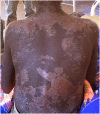The burden of human African trypanosomiasis
- PMID: 19104653
- PMCID: PMC2602597
- DOI: 10.1371/journal.pntd.0000333
The burden of human African trypanosomiasis
Abstract
Human African trypanosomiasis (HAT, or sleeping sickness) is a protozoan parasitic infection caused by Trypanosoma brucei rhodesiense or Trypanosoma brucei gambiense. These are neglected tropical diseases, and T.b. rhodesiense HAT is a zoonosis. We review current knowledge on the burden of HAT in sub-Saharan Africa, with an emphasis on the disability-adjusted life year (DALY), data sources, and methodological issues relating to the use of this metric for assessing the burden of this disease. We highlight areas where data are lacking to properly quantify the impact of these diseases, mainly relating to quantifying under-reporting and disability associated with infection, and challenge the HAT research community to tackle the neglect in data gathering to enable better evidence-based assessments of burden using DALYs or other appropriate measures.
Conflict of interest statement
There are no financial, personal, or professional interests that could be construed to have influenced this paper. PL is the Head of research at the National Control Programme against HAT in DRC.
Figures


References
-
- Picozzi K, Carrington M, Welburn SC. A multiplex PCR that discriminates between Trypanosoma brucei brucei and zoonotic T. b. rhodesiense. Exp Parasitol. 2008;118:41–46. - PubMed
-
- Radwanska M, Claes F, Magez S, Magnus E, Perez-Morga D, et al. Novel primer sequences for polymerase chain reaction-based detection of Trypanosoma brucei gambiense. Am J Trop Med Hyg. 2002;67:289–295. - PubMed
-
- Gooding RH, Krafsur ES. Tsetse genetics: applications to biology and systematics. In: Maudlin I, Holmes PH, Miles MA, editors. The trypanosomiases. Wallingford: CABI; 2004. pp. 95–111.
-
- Onyango RJ, van Hoeve K, de Raadt P. The epidemiology of Trypanosoma rhodesiense sleeping sickness in Alego location, central Nyanza, Kenya. I. Evidence that cattle may act as reservoir hosts of trypanosomes infective to man. Trans R Soc Trop Med Hyg. 1966;60:175–182. - PubMed
Publication types
MeSH terms
Grants and funding
LinkOut - more resources
Full Text Sources
Other Literature Sources

